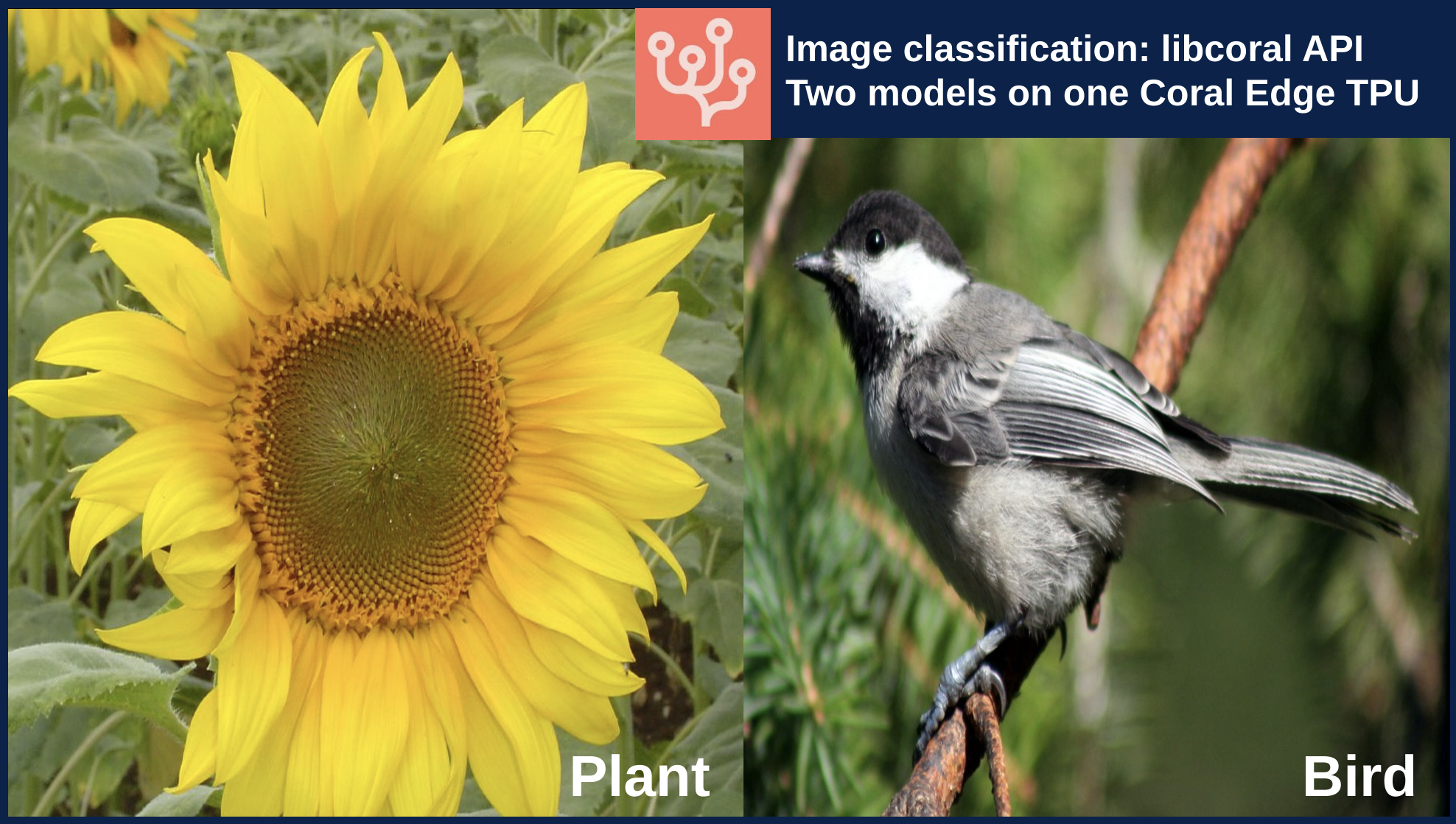This article explains how to build an example using the libcoral API[1]. The libcoral is a C/C++ API, which is used for three main purposes:
- Inferencing: facilitates the implementation of neural network inference on Coral Edge TPU™
- Pipelining: provides functions to pipeline a model on multiple Coral Edge TPUs
- Transfer learning: enables on board transfer learning
Several examples can be found on the libcoral GitHub[2]. This article only shows how to build a simple image classification example from scratch. The method used here can easily be applied to other examples.
1. Description[edit | edit source]
This simple example is based on two image classification models, which allow the identification of the subject represented by an image.
The purpose of this example is beyond the image classification aspect to demonstrate how to use the libcoral API to realize inferences of two models alternatively on only one Google Coral Edge TPU™[3].
This example depends only on the TensorFlow™ Lite[4] interpreter and the libraries associated to the Google Coral Edge TPU™[3].
The models used with this example are two variants, Inat_bird and Inat_plant respectively for bird and plant classification of the MobileNet v2 downloaded from the Coral GitHub testing models[5].
2. Installation[edit | edit source]
2.1. Install from the OpenSTLinux AI package repository[edit | edit source]
After having configured the AI OpenSTLinux package, you can install the X-LINUX-AI components for this example:
x-linux-ai -i libcoral
2.2. Source code location[edit | edit source]
The source code and the header files of this example are located in the libcoral API examples GitHub [6].
3. How to use the example[edit | edit source]
3.1. Installation of the X-LINUX-AI SDK[edit | edit source]
First of all, the installation of the X-LINUX-SDK is required to be able to cross-compile AI applications for STM32 boards.
3.2. Start the SDK[edit | edit source]
| The SDK environment setup script must be run once on each new working terminal on which you cross-compile. |
Once the OpenSTLinux SDK is installed, go to the installation directory and source the environment:
cd <working directory absolute path>/Developer-Package/SDK
source unknown package
source unknown package
3.3. Set up the file tree[edit | edit source]
This example requires the following file tree to operate out of the box:
mkdir -p sources/coral/examples cd sources/coral/examples
3.4. Download the example[edit | edit source]
As mentioned before the source and header files must be downloaded from the libcoral API examples GitHub [6]:
wget https://raw.githubusercontent.com/google-coral/libcoral/master/coral/examples/two_models_one_tpu.cc wget https://raw.githubusercontent.com/google-coral/libcoral/master/coral/examples/file_utils.cc wget https://raw.githubusercontent.com/google-coral/libcoral/master/coral/examples/file_utils.h
3.5. Create the Makefile[edit | edit source]
Create the following Makefile in the sources/coral/examples directory:
# Copyright (c) 2022 STMicroelectronics
TARGET_BIN = two_models_one_tpu
CXXFLAGS += -Wall $(shell pkg-config --cflags absl_base libglog)
CXXFLAGS += -I../../
# Fix undefined reference during the link
CXXFLAGS += -std=c++11
LDFLAGS = $(shell pkg-config --libs absl_base libglog)
LDFLAGS += -lcoral -ledgetpu -ltensorflow-lite -lglog
LDFLAGS += \
-labsl_flags_internal \
-labsl_flags_marshalling \
-labsl_flags_reflection \
-labsl_statusor \
-labsl_flags_parse \
-labsl_strings \
-labsl_throw_delegate
SRCS = two_models_one_tpu.cc file_utils.cc
OBJS = $(SRCS:.cc=.o)
all: $(TARGET_BIN)
$(OBJS): $(SRCS)
$(CXX) $(CXXFLAGS) -c $^
$(TARGET_BIN): $(OBJS)
$(CXX) $(LDFLAGS) $^ -o $@
clean:
rm -rf $(OBJS) $(TARGET_BIN)
Minimal required libraries like Abseil, Glog, Tflite, Edgetpu, and Coral are linked during the cross-compilation.
3.6. Download and prepare test data[edit | edit source]
An additional package is necessary on the host PC to preprocess data for this example: imagemagick
apt-get install imagemagick
First create the directory to store test data:
mkdir edgetpu_cpp_example
Next download the models and the test pictures:
wget -O edgetpu_cpp_example/inat_plant_edgetpu.tflite https://github.com/google-coral/edgetpu/raw/master/test_data/mobilenet_v2_1.0_224_inat_plant_quant_edgetpu.tflite wget -O edgetpu_cpp_example/inat_bird_edgetpu.tflite https://github.com/google-coral/edgetpu/raw/master/test_data/mobilenet_v2_1.0_224_inat_bird_quant_edgetpu.tflite wget -O edgetpu_cpp_example/inat_plant_labels.txt https://github.com/google-coral/edgetpu/raw/master/test_data/inat_plant_labels.txt wget -O edgetpu_cpp_example/inat_bird_labels.txt https://github.com/google-coral/edgetpu/raw/master/test_data/inat_bird_labels.txt wget -O edgetpu_cpp_example/bird.jpg https://farm3.staticflickr.com/8008/7523974676_40bbeef7e3_o.jpg wget -O edgetpu_cpp_example/plant.jpg https://c2.staticflickr.com/1/62/184682050_db90d84573_o.jpg
Finally preprocess the pictures to make them fit with the inputs shape of the models:
cd edgetpu_cpp_example && convert bird.jpg -resize 224x224! bird.rgb && convert plant.jpg -resize 224x224! plant.rgb
3.7. Cross-compilation and launch[edit | edit source]
Run the cross-compilation:
cd .. make
Once the compilation is finished, a binary file named two_models_one_tpu has been created.
Copy the binary file and the test data directory onto the board:
scp -r edgetpu_cpp_example/ root@<board_ip>:/path/ scp two_models_one_tpu root@<board_ip>:/path/
| The Coral Edge TPU™ must be plugged on the board before launching the script |
Connect to the board and launch the example:
./two_models_one_tpu
After 2000 inferences the result is:
Running model: edgetpu_cpp_example/inat_bird_edgetpu.tflite and model: edgetpu_cpp_example/inat_plant_edgetpu.tflite for 2000 inferences [Bird image analysis] max value index: 659 value: 0.652344 [Plant image analysis] max value index: 1680 value: 0.964844 Using one Edge TPU, # inferences: 2000 costs: 106.278 seconds.
Where the max value index represents the index of the class detected and the value represents the confidence. On these particular pictures, the bird detected is a poecile atricapillus (black-capped chickadee) and the plant is a helianthus annuus (sunflower). The index and the name of each class are available in the inat_bird_labels.txt and inat_plant_labels.txt stored in the edgetpu_cpp_example directory.
4. References[edit | edit source]
